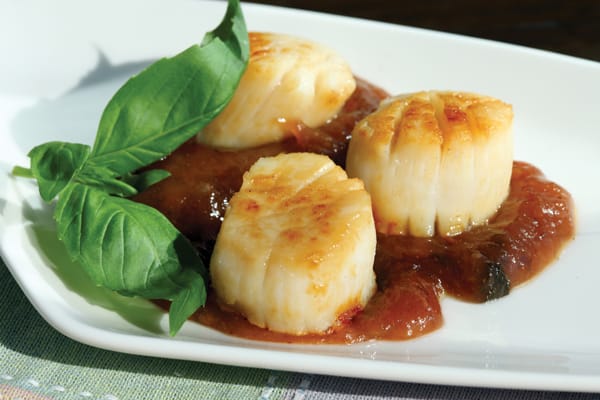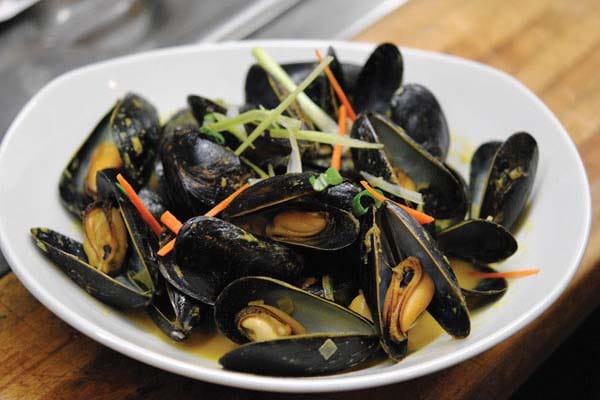3 chefs’ tips for preparing scallops
Alan Crosby, Executive Chef, White Point Beach Resort, Liverpool, NS: “One of my favorite things is a perfectly seared scallop, cooked on one side only—mahogany brown, crispy—with a centre that’s barely warm, a sprinkle of salt and a crack of pepper. If you’re pan-frying, dry them thoroughly. Get your pan so hot they scream when you put them in—but don’t overcook them. They should be slightly translucent in the centre.”
Stefan Müller, Executive Chef, Delta Beausejour, Moncton: “Bay of Fundy scallops have a beautiful texture and are very versatile. You can add different flavours and garnishes, or enjoy them simply as they come from the shell. You can also use frozen scallops as long as they are IQF scallops (individually quick frozen), because they don’t shrink before cooking. But never defrost scallops on the counter or under running water; always defrost them in the refrigerator.”
Gordon Bailey, Executive Chef and Owner, Lot 30, Charlottetown: “Scallops are the sweetest thing from the sea, and one of the easiest things to cook. But you’ve got to have a heavy bottomed pan. Add a little canola oil. Make sure you pat your scallops until they are really dry. They should be 10/20 count, meaning that there are 10 to 20 scallops per pound. Season with a little salt, and place them in the hot pan until there’s a nice crust—about 45 seconds. Add a little knob of butter on top of each one, flip and cook for another 10 seconds. Done! If you cook scallops this way, you’ll be in love with them forever.”

There is nothing more sensual than hearing the soft moan and the absolute look of pleasure on a woman’s face (or a man’s, for that matter) as she bites into a perfectly cooked scallop, and experiences the soft texture and exquisite taste on the palate. It’s not necessarily meant for the bedroom,” says executive chef Dale Nichols, “but it could lead to kitchen sex when all the stars align at the same time.”
Nichols heads the culinary team at Digby Pines Golf Resort and Spa in Digby, NS, and he loves telling guests the story of how he fell in love with scallops. It happened in the late ’70s, when he was a student at Acadia University. The yet-to-be-chef went on a scuba diving expedition in Sheet Harbour, NS, with three buddies, in search of scallops. After buying licences for a dollar—which allowed them 100 scallops each—they headed to the ocean. “After an hour and a half of carefully picking scallops, our dive bag looked like the Grinch’s bag after he cleaned out Whoville,” says Nichols. The loot was 396 scallops; after shucking for two hours, they netted about 23 kilograms (50 pounds) of meat.
“We traveled back to Acadia—victors in our own right—and in the small university dorm lounge, fried up the freshest scallops money can’t buy, and ate them with toasted and buttered English muffins.”
Although Nichols has since prepared thousands scallops over the past 30 years, he’s never forgotten the taste and smell of cooking that first batch, “in a primitive Teflon frying pan, on a two-burner electric element, seasoned only with salt and pepper and washed down with some ice cold beer. Glorious. I can still taste them.”
Now, Nichols and his team prepare 70-90 kilograms (150-200 pounds) of scallops a week. His advice? “Don’t over-season. God didn’t create scallops so man could try to re-create them. Enjoy their delicate flavour married with a complementary condiment or subtle sauce. And, when you’re buying them, look for scallops that have some spring in their step. Make sure they stand tall and perky.” 
For storage, he recommends placing them in a sealed container on a layer of paper towel, or on a rack, so any juice that drips out will settle below, and the scallop won’t sit in liquid and get soggy.
As an afterthought, he adds, “Scallops are best eaten fresh—so why store them at all? Cook them immediately!"



